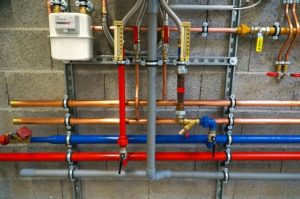Water is the lifeblood of hydronic systems. Its chemical characteristics can make the difference between a system that lasts for decades and one that develops expensive corrosion issues within months of startup. Pure water consists of only hydrogen and oxygen. It is colorless, tasteless, and odorless. Unfortunately, “pure” water does not exist in nature. Because water is the universal solvent, water from springs, wells, and even municipal mains contains dissolved minerals such as calcium and magnesium; sediment such as fine silica sand or organic particles; and dissolved gases such as oxygen, carbon dioxide and hydrogen sulfide. Some water sources also contain microorganisms such as bacteria or algae. There can be wide variations in these impurities from one water source to another.
The water used by your commercial property contains many impurities that can have a negative effect on your hydronic system. At Quality Plumbing & Heating, Inc., we recommend improving the water quality in your hydronic system through demineralization and chemical treatment. Here are a few things you should know about demineralizing your water.
Ion Removal Process
One of the best ways to minimize the potential for undesirable chemical reactions within hydronic systems is to demineralize the water. As its name implies, demineralization involves removing undesirable minerals such as the dissolved calcium and magnesium compounds found in most groundwater and municipal water systems. From a process standpoint, demineralization is similar to water softening; both are ion exchange processes. The undesirable ions in the source water, which come from dissolved salts containing calcium, magnesium, manganese and chlorine, are captured and exchanged for sodium ions that do not precipitate out of water when it’s heated.
Softened water is better than the original water from the standpoint of its ability to form scale, but it’s still not “pure water” and it’s still not the optimal fluid for a closed-loop hydronic system. The presence of sodium ions in softened water leaves the water with relatively high electrical conductivity. This characteristic increases the likelihood of galvanic corrosion between dissimilar materials in the system (such as copper and iron). Softening solves one problem (i.e., removing calcium and magnesium ions from the source water, which would otherwise cause scaling), but creates another potential problem by leaving the water in a state that’s “cooperative” with electrical charges.
Internal Washing
Although demineralization is the method for improving water quality in hydronic systems, we also recommend that it’s preceded with a thorough internal washing of the system and followed by adding a stabilizing chemical formulation.
Internal washing is performed by filling the system with water, adding a “hydronic detergent” formulation and circulating this blend through the entire system for at least one hour. The hydronic detergent breaks down oils and greases within the system and suspends them in the circulating fluid. At the end of the wash cycle, this fluid is completely drained from the system and disposed of according to the detergent supplier’s directions. Most detergents are biodegradable and easy to dispose of.
If you want your hydronic system to perform well and have a long service life, consult Quality Plumbing & Heating to discuss our water treatment options. If you’re in the Kokomo or Greensburg, IN, area, call us today at (833) 235-9260 to schedule an appointment.
Source: supplyht.com

